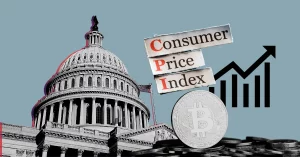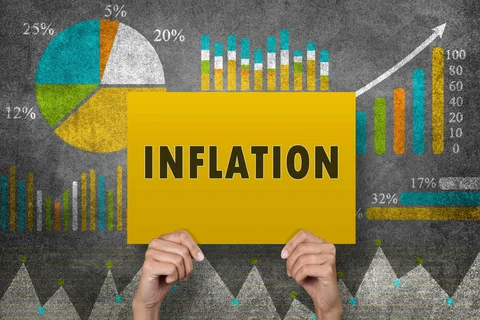Analysis of Current Economic Indicators

Analyzing US Inflation Trends using current economic indicators reveals a complex picture shaped by various factors. The Consumer Price Index (CPI), Producer Price Index (PPI), and employment rates are some of the primary indicators used to gauge inflation. Over the past year, the US has experienced fluctuating inflation rates, partly due to the pandemic’s lingering effects on supply chains and consumer behavior. The CPI has shown significant year-over-year increases, driven by higher prices for goods and services. Similarly, the PPI, which measures the average change over time in the selling prices received by domestic producers for their output, has also indicated upward trends, suggesting that producers are passing on higher costs to consumers.
Future projections based on US Inflation Trends analysis suggest that inflation may remain elevated in the near term. Several factors contribute to this forecast, including ongoing supply chain disruptions, robust consumer demand, and potential wage pressures. Economists predict that while inflation rates may moderate from their recent peaks, they are unlikely to return to pre-pandemic levels immediately. The Federal Reserve’s monetary policy decisions, global economic conditions, and domestic fiscal policies will play crucial roles in shaping these trends. By closely monitoring current economic indicators, analysts can provide more accurate projections and help policymakers and businesses prepare for future economic conditions.
Impact of Monetary Policies
The impact of monetary policies on US inflation trends is profound, as these policies directly influence the money supply, interest rates, and overall economic activity. The Federal Reserve, tasked with maintaining price stability and full employment, uses tools such as interest rate adjustments and asset purchases to manage inflation. In response to the recent surge in inflation, the Fed has signaled potential interest rate hikes and a reduction in its asset purchase program. These actions are intended to cool down the economy by making borrowing more expensive and reducing the money supply, thereby curbing inflationary pressures. However, the timing and magnitude of these policy changes are critical, as overly aggressive measures could stifle economic growth and lead to a recession.
Monetary policies shaping future US inflation projections are likely to focus on achieving a delicate balance between controlling inflation and supporting economic growth. The Federal Reserve’s forward guidance and communication strategy will be essential in managing market expectations and investor sentiment. By clearly articulating its policy intentions and responding to evolving economic conditions, the Fed can help stabilize inflation expectations and foster a more predictable economic environment. As new data emerges, the Fed will need to adjust its policies accordingly to ensure that inflation remains within target ranges while minimizing adverse impacts on economic activity.
Potential Global Influences

Global supply chain issues affect US Inflation Trends by disrupting the flow of goods and increasing production costs. The COVID-19 pandemic has exposed vulnerabilities in global supply chains, leading to shortages of critical components and raw materials. These disruptions have caused delays and increased costs for manufacturers, which are often passed on to consumers in the form of higher prices. Additionally, geopolitical tensions, trade policies, and natural disasters can further exacerbate supply chain challenges, contributing to inflationary pressures in the US. As global economies recover and supply chains gradually stabilize, these inflationary pressures may ease, but the timeline for resolution remains uncertain.
Foreign exchange rates influence US Inflation Trends by affecting the cost of imported goods and services. A weaker US dollar makes imports more expensive, contributing to higher inflation, while a stronger dollar can help mitigate inflationary pressures by reducing the cost of imports. Exchange rate fluctuations are influenced by various factors, including interest rate differentials, economic growth prospects, and geopolitical events. As the US and other major economies adjust their monetary policies, exchange rates may experience increased volatility, further impacting inflation trends. By closely monitoring global economic developments and exchange rate movements, policymakers can better anticipate and respond to potential inflationary pressures.
Consumer Price Index Predictions
CPI predictions align with US Inflation Trends analysis, providing valuable insights into future inflationary pressures. The Consumer Price Index measures the average change over time in the prices paid by urban consumers for a market basket of consumer goods and services. Recent CPI data has shown significant increases, reflecting higher costs for housing, food, energy, and transportation. These trends are expected to continue in the near term, driven by ongoing supply chain disruptions, robust consumer demand, and potential wage pressures. By analyzing CPI data, economists can better understand the underlying factors driving inflation and make informed projections about future trends.
Future CPI projections indicate sustained US Inflation Trends, suggesting that inflation may remain elevated for an extended period. While some temporary factors contributing to recent inflation spikes may subside, structural factors such as labor market tightness and supply chain adjustments could maintain upward pressure on prices. Economists predict that while inflation rates may moderate from their recent peaks, they are unlikely to return to pre-pandemic levels immediately. By closely monitoring CPI data and other economic indicators, analysts can provide more accurate projections and help policymakers and businesses prepare for future economic conditions.
Market Expectations and Investor Sentiment

Market Expectations: US Inflation Trends and economic forecasts alignment are crucial for maintaining market stability and investor confidence. Financial markets closely monitor inflation trends and economic forecasts to gauge the likely trajectory of interest rates, corporate earnings, and overall economic activity. When inflation trends align with economic forecasts, it helps reduce uncertainty and fosters a more predictable investment environment. However, unexpected inflationary pressures or deviations from forecasts can lead to increased market volatility and risk aversion. By providing transparent and accurate economic forecasts, policymakers and analysts can help manage market expectations and support a stable investment climate.
Investor Sentiment: US Inflation Trends impact on market confidence is significant, as inflation directly affects purchasing power, corporate profitability, and investment returns. Elevated inflation can erode consumer and business confidence, leading to reduced spending and investment. Conversely, well-managed inflation within target ranges can support economic growth and market stability. Investors closely monitor inflation trends and central bank policies to assess potential risks and opportunities. By maintaining clear communication and responsive policy measures, central banks can help stabilize investor sentiment and promote a healthy economic environment. As new data emerges, investors will continue to adjust their strategies based on evolving inflation trends and economic conditions.












